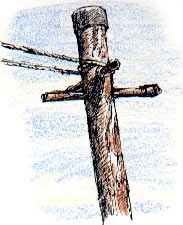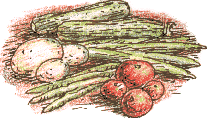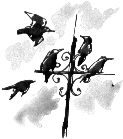
|
Clothes PostSunday, 15th June 2003, page 2 of 2, West Yorkshire |
![]()
![]()
![]()
![]() Rocks | History |
Workshop |
Links | Home
Page
Rocks | History |
Workshop |
Links | Home
Page
![]()
 It's
such a perfect summer's afternoon. Too warm to work on the garden. As
we sit in the shade of a parasol this old clothes post at the end of the
lawn by the pond strikes me as the most interesting subject to draw.
It's
such a perfect summer's afternoon. Too warm to work on the garden. As
we sit in the shade of a parasol this old clothes post at the end of the
lawn by the pond strikes me as the most interesting subject to draw.
I'm afraid that most of the garden designers that I come across on television wouldn't recommend this as a piece of garden furniture.
'We're putting up a trellis,' said Alan Titchmarsh in one garden make-over show, 'to block the view of Mrs Wiggin's washing next door.'
Fair enough, but he also suggests: 'Yes, I know it smells better dried outside but please, now that you've redesigned your garden, put it in the tumble drier!' (I'm quoting these from memory, but it was words to that effect).
 I'm
more in agreement with self-sufficiency advocate John Seymour,
who bemoans, in The Self-Sufficient Gardener: 'Gardens acquired
a new role, that of a status symbol in the game of keeping up with the
neighbours. The vegetable yield ceased to be the vital factor; instead
such matters as the greenness of the lawn and the display of flowers were
all important.'
I'm
more in agreement with self-sufficiency advocate John Seymour,
who bemoans, in The Self-Sufficient Gardener: 'Gardens acquired
a new role, that of a status symbol in the game of keeping up with the
neighbours. The vegetable yield ceased to be the vital factor; instead
such matters as the greenness of the lawn and the display of flowers were
all important.'
It does seem a shame to me that fossil fuel is being used to produce the electricity that will power the tumble drier that is switched on even on a sunny day like today.
The Clothes Post and the Cross
For a western artist I don't think it is possible to draw this subject,
something as commonplace as a clothes post, without feeling some of the
symbolism of the cross and the crucifixion. It's not that I'm especially
religious, in fact I'm hardly religious at all in any conventional sense
(whatever 'conventional sense' means these days), but the crucifixion
is so much a part of western art that I can't get away from it's echoes.
 The
image, always there in church, was such a part of my upbringing. I didn't
spot the symbolism in the clothes post until I started drawing but it's
not surprising that I couldn't escape it, with all that conditioning.
The
image, always there in church, was such a part of my upbringing. I didn't
spot the symbolism in the clothes post until I started drawing but it's
not surprising that I couldn't escape it, with all that conditioning.
 There
are echoes of the 'old rugged cross', of nails, of rusty blood stains,
of scourging and binding. A kestrel has just flown across the blue sky
behind the top of the post as I wrote that.
There
are echoes of the 'old rugged cross', of nails, of rusty blood stains,
of scourging and binding. A kestrel has just flown across the blue sky
behind the top of the post as I wrote that.
Hirst's Last Supper
Even if I was religious I wouldn't want any overt symbolism in a garden. There's quite enough in the cycles of growth and rebirth in the garden plants, pond and veg beds, thank you!
I was reading this morning on news.bbc.co.uk:
Artist Damien Hirst has unveiled a new religious work that uses 13 ping pong balls and spurting red wine to represent Leonardo Da Vinci's Last Supper.
Hirst, who grew up in Leeds, describes himself as a lapsed Catholic and considers that 'science, religion and art' are equal forces in his art. In his next show he sets out to explore the 'collision of science and religion, and how they're failing, and working and surviving together'.
I've never seen Hirst's work and I don't know if this work is intended just to be ironic, thought-provoking or a bit shocking or whether there's something deeper there; there probably is. Although he's portrayed as a showman in the Grand Guignol tradition I think I detect something of the mystic visionary in his work.
Jonathan Miller once argued that a fountain makes a more accurate metaphor for what a human being is than a statue. We're a living dynamic system, like the fountain, not a lifeless, set-in-stone, decaying facsimile of a pattern, however perfect and accurate that may appear to be, like the statue.
Miller was talking of us in strictly physical terms but you could make a similar point about religion. When it ceases to be a vibrant dynamic spirit running through us and through the universe and it becomes set-in-stone; a series of words (even wise words) repeated over and over until the sense dies or when it becomes a kind of fixed, changeless, consumer item, like plaster saints and plastic crucifixes; when it constantly refers to itself and its own God-given authority and ignores the real world of others outside its circle (I'm being a bit unfair here, I know that genuinely religious people aren't so inward looking); when it sidesteps the meaning of nature: then it really has lost it's meaning.
Last Post
But for me the real spiritual insight would be if I could ever draw that post just as itself; a rusty weather-beaten post, without the burden of all these layers of meaning that my upbringing imposes on it.
More than that, if I could stop looking it as a rusty weather-beaten post - even that's being a bit sentimental and anthropomorphic, isn't it? - and see it as the arrangement of abstract coloured shapes, then I think I would be beginning to find some maturity in my artwork and in my spiritual development.
Who do I think cuts the mustard these days as a religious artist, or
an artist depicting religion, I should say? - Hirst with his thought-provoking
fountain or, if you can imagine it, an artist who does reverent, pious,
sunny, glossy, scrubbed depictions of haloed Messiahs and Apostles? Well,
what do you think?!
![]()
![]() Next page |
Previous page | This
day in 1999 | This month |
Nature Diary |
Home
Page
Next page |
Previous page | This
day in 1999 | This month |
Nature Diary |
Home
Page
![]()